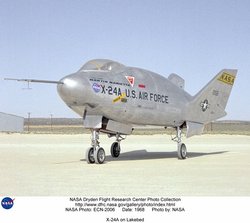Lifting body
|
|
The lifting body is an aircraft configuration where the body itself produces lift. It is related to, but the opposite of, a flying wing, an aircraft whose fuselage is contained by the wing.
 The Martin Aircraft Company X-24 built as part of a 1963 to 1975 experimental US military program |
Missing image LiftingBodies.jpg X-24A, M2-F3 and HL-10 Lifting bodies (NASA) |
Lifting body research arose from the idea of spacecraft re-entering the Earth's atmosphere and landing much like a regular aircraft. The traditional capsule-like spacecraft had very little control over where they landed once they re-entered the Earth's atmosphere. A steerable spacecraft with wings could significantly extend the landing envelope. Wings would have to be built that could withstand stresses and temperatures at hypersonic speeds. A proposed answer was to eliminate wings altogether: Design the body itself to produce lift. The Space Shuttle contains some of the lifting body principles, although it relies more on the delta wing concept.
Research on lifting bodies began in 1962 with Dale Reed of NASA's Dryden Flight Research Center. The first full-size model, the NASA M2-F1, was made of wood. Initial tests were performed by towing the craft along a dry lakebed behind a modified Pontiac Catalina [1] (http://www.classicalpontiac.com/articles/nasa.html). Later the craft was towed from behind a C-47 and released. Since the M2-F1 was a glider, a small rocket motor was added in order to extend the landing envelope. The M2-F1 was soon nicknamed the "Flying Bathtub".
In 1963, NASA began experimenting with heavier rocket powered craft dropped from a B-52 Bomber. (Of the Dryden lifting bodies, all but the NASA M2-F1 used an XLR-11 rocket engine like the famous Bell X-1.) A follow-on design was the Northrop HL-10, developed at NASA's Langley Research Center. The X-24A and X-24B were based on the M-2 concept originated by Alfred Eggers in 1957 at NASA Ames Research Center (called the Ames Aeronautical Laboratory in 1957), Moffett Field, Mountain View, California. The M-2 competed in the design of the Space Shuttle.
A major difficulty with these designs was air flow separation; the air stream would become very turbulent causing loss of control and lift. The HL-10 attempted to solve part of this problem by angling the port and starboard vertical stablizers outward and enlarging the center one. This air flow problem caused the crash of the Northrop M2-F2 lifting body. The rebuilt M2-F2 (now called the Northrop M2-F3) added a central rudder to correct the aerodynamic flaw of its predecessor.
Much of the general public had never heard, or seen, anything about these lifting body designs until watching the 1970s television show The Six Million Dollar Man. The introduction footage showed the M2-F2, piloted by Bruce Peterson, crashing and tumbling violently along the runway. Bruce Peterson survived to fly again and, the craft was rebuilt as the M2-F3.
The lifting body concept has been considered for many other aerospace programs, including the Lockheed Martin X-33, BAC's Multi Unit Space Transport And Recovery Device, Europe's EADS Phoenix and the Russian-European cooperation Kliper spaceship.
List of Dryden Flight Research Center lifting body vehicles (1963 to 1975)
Lifting body pilots and flights
| Pilot | M2-F1 | M2-F2 | HL-10 | HL-10 mod | M2-F3 | X-24A | X-24B | Total |
|---|---|---|---|---|---|---|---|---|
| Milton O. Thompson | 45 | 5 | - | - | - | - | - | 50 |
| Bruce Peterson | 17 | 3 | 1 | - | - | - | - | 21 |
| Chuck Yeager | 5 | - | - | - | - | - | - | 5 |
| Donald L. Mallick | 2 | - | - | - | - | - | - | 2 |
| James W. Wood | * | - | - | - | - | - | - | * |
| Donald M. Sorlie | 5 | 3 | - | - | - | - | - | 8 |
| William H. Dana | 1 | - | - | 9 | 19 | - | 2 | 31 |
| Jerauld R. Gentry | 2 | 5 | - | 9 | 1 | 13 | - | 30 |
| Fred Haise | * | - | - | - | - | - | - | * |
| Joe Engle | * | - | - | - | - | - | - | * |
| John A. Manke | - | - | - | 10 | 4 | 12 | 16 | 42 |
| Peter C. Hoag | - | - | - | 8 | - | - | - | 8 |
| Cecil W. Powell | - | - | - | - | 3 | 3 | - | 6 |
| Michael V. Love | - | - | - | - | - | - | 12 | 12 |
| Einar K. Enevoldson | - | - | - | - | - | - | 2 | 2 |
| Francis Scobee | - | - | - | - | - | - | 2 | 2 |
| Thomas C. McMurtry | - | - | - | - | - | - | 2 | 2 |
| TOTAL | 77 | 16 | 1 | 36 | 27 | 28 | 36 | 221 |
- Wood, Haise and Engle each made a single, car-towed, ground flight of the M2-F1.
External links
- Lifting Bodies Fact Sheet (NASA) (http://www.dfrc.nasa.gov/Newsroom/FactSheets/FS-011-DFRC.html)
- NASA Photo Collections from Dryden Flight Research Center
- HL-10 (http://www.dfrc.nasa.gov/gallery/photo/HL-10/)
- M2-F1 (http://www.dfrc.nasa.gov/gallery/photo/M2-F1/)
- M2-F2 (http://www.dfrc.nasa.gov/gallery/photo/M2-F2/)
- M2-F3 (http://www.dfrc.nasa.gov/gallery/photo/M2-F3/)
- X-24A and X24B (http://www.dfrc.nasa.gov/gallery/photo/X-24/)
- Short M2-F1 history (http://members.lycos.co.uk/derekhorne/m2f1.html)
- Some history of lifting body flight (http://www.centennialofflight.gov/essay/Evolution_of_Technology/lifting_bodies/Tech29.htm)
- Wingless Flight: The Lifting Body Story. NASA History Series SP-4220 1997 PDF (http://ntrs.nasa.gov/archive/nasa/casi.ntrs.nasa.gov/19980169231_1998082126.pdf)de:Lifting Body
